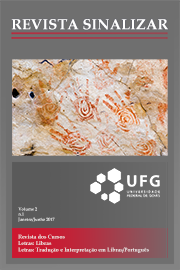Dictionary Deit-Libras in ELiS project: analyzing ELiS
DOI:
https://doi.org/10.5216/rs.v2i1.38558Keywords:
ELiS, Dictionary, Libras, Sign writing, Data base.Abstract
In 2014, Reading and Writing Laboratory of Sign Languages developed an ambitious research project which consisted in writing in ELiS all the signs from the dictionary Novo DEIT-Libras. ELiS is the Brazilian system of sign language writing and Novo DEIT-Libras is the largest dictionary of Brazilian Sign Language nowadays. The main goal of the project was, by writing all of the dictionary’s entries, to accomplish possible adjustments to ELiS, in respect to its rules or visographemes. Besides this, as a esearch product, we planned to create a data base with the signs resented in the dictionary and written in ELiS, in order to enable electronic search of Libras data, via visographemes or visographeme roups. To the realization of the research, we developed specific methodology based on writing and ensuing review stages. Even though e needed to enhance some changes in some of the rules and isographemes, these were minor changes, which only serves to prove he already known efficiency of ELiS in representing Libras.Downloads
References
BARROS, M. E. ELiS: sistema brasileiro de escrita das línguas de sinais. Porto Alegre: Penso, 2015. 109. Revista Sinalizar, Goiânia, v. 2, n.1, p. 96 - 109, jan. / jun., 2017 ISSN: 2448-0797
BRIEN, D. Dictionary of British Sign Language / English. London: Faber and Faber, 1992.
CAPOVILLA, F. C.; RAPHAEL, W. D.; MAURICIO, A. C. Novo DEIT-Libras: Dicionário Enciclopédico Ilustrado Trilíngue da Língua de Sinais Brasileira. Vol. 1 e 2. 3ª ed. São Paulo: Edusp, 2013.
COLLISON, R. L. A history of foreign-language dictionaries. London: André Deutsch, 1982.
FERNANDES, L. A. ELiS: internacionalização da escrita das línguas de sinais. Saarbrücken, Deutschland: Novas Edições Acadêmicas, 2015.
HANKE, T. HamNoSys – Representação de Dados de Língua de Sinais em Contextos de Processamento e Recursos de Linguagem, 1984. http://www.sign-lang.uni-hamburg.de/dgs-korpus/tl_files/inhalt_pdf/HankeLRECSLP2004_05.pdf (acesso em 29 mai 2015).
OVIEDO, A. Roch Ambroise Auguste Bébian. http://www.cultura-sorda.eu (acesso em 29 mai 2015).
STOKOE, W.; CASTERLINE, D.; CRONEBERG, C.A. Dictionary of American Sign Language Linguistic Principles. Washington: Gallaudet, 1965.
SUTTON, V. Sign writing for everyday use. La Jolla: Deaf Action Committee for Sign Writing, 1981.
Downloads
Published
How to Cite
Issue
Section
License
Copyright

This work is licensed under a Creative Commons Attribution-NonCommercial-NoDerivatives 4.0 International License.
Autores que publicam nesta revista concordam com os seguintes termos:
Autores mantém os direitos autorais e concedem à revista o direito de primeira publicação, com o trabalho simultaneamente licenciado sob a Creative Commons Attribution License que permitindo o compartilhamento do trabalho com reconhecimento da autoria do trabalho e publicação inicial nesta revista.
Autores têm autorização para assumir contratos adicionais separadamente, para distribuição não-exclusiva da versão do trabalho publicada nesta revista (ex.: publicar em repositório institucional ou como capítulo de livro), com reconhecimento de autoria e publicação inicial nesta revista.







